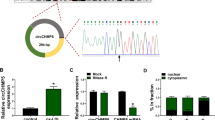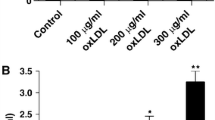Abstract
This paper investigated the effects of ox-LDL on PCSK9, and the molecular mechanisms of PCSK9 siRNA-inhibited apoptosis induced by ox-LDL in human umbilical vein endothelial cells (HUVECs), to clarify the role of PCSK9 in atherosclerogenesis. HUVECs were incubated with ox-LDL for 24 h. The apoptosis was observed by Hoechst 33258 staining. The expression of PCSK9, LOX-1 mRNAs and proteins was detected by RT-PCR, western blot, respectively. The PCSK9 siRNAs labeled with fluorescence were transfected into HUVECs by Lipofectamine 2000. After transfection for 24 h, cells were treated with ox-LDL for 24 h, HUVECs apoptosis transfected siRNA was detected by Hoechst 33258 staining and flow cytometer. The expression of Bcl-2, Bax, caspase3, 8, 9 was detected by western blot. The activity of caspase3, 9 was detected by kits. Our results showed that apoptosis of HUVECs and the expressions of PCSK9 and LOX-1 were upregulated secondary to induction by ox-LDL in a concentration-dependent manner. However, ox-LDL-induced HUVEC apoptosis and PCSK9 expression, but not LOX-1 expression, were significantly reduced by PCSK9 siRNA. These results demonstrate a linkage between HUVEC apoptosis and PCSK9 expression. Furthermore, we detected the possible pathway involved in apoptotic regulation by PCSK9 siRNA; our results showed that the expression of Bcl-2 decreased, whereas that of Bax increased. In addition, ox-LDL enhanced the activity of caspase9 and then caspase3. Pretreatment of HUVECs with PCSK9 siRNA blocked these effects of ox-LDL. These findings suggest that ox-LDL-induced HUVECs apoptosis could be inhibited by PCSK9 siRNA, in which Bcl/Bax–caspase9–caspase3 pathway maybe was involved through reducing the Bcl-2/Bax ratio and inhibited the activation of both caspase9 and 3.












Similar content being viewed by others
References
Horton JD, Cohen JC, Hobbs HH (2007) Molecular biology of PCSK9: its role in LDL metabolism. Trends Biochem Sci 32:71–77
Hedrick JA (2009) Targeting PCSK9 for the treatment of hypercholesterolemia. Curr Opin Investig Drugs 10:938–946
Horton JD, Cohen JC, Hobbs HH (2009) PCSK9: a convertase that coordinates LDL catabolism. J Lipid Res 50(Suppl):S172–S177
Chen SN, Ballantyne CM, Gotto AM Jr, Tan Y, Willerson JT, Marian AJ (2005) A common PCSK9 haplotype, encompassing the E670G coding single nucleotide polymorphism, is a novel genetic marker for plasma low-density lipoprotein cholesterol levels and severity of coronary atherosclerosis. J Am Coll Cardiol 45:1611–1619
Abboud S, Karhunen PJ, Lütjohann D, Goebeler S, Luoto T, Friedrichs S, Lehtimaki T, Pandolfo M, Laaksonen R (2007) Proprotein convertase subtilisin/kexin type 9 (PCSK9) gene is a risk factor of large-vessel atherosclerosis stroke. PLoS One 2(10):e1043
Naoumova RP, Tosi I, Patel D, Neuwirth C, Horswell SD, Marais AD, van Heyningen C, Soutar AK (2005) Severe hypercholesterolemia in four British families with the D374Y mutation in the PCSK9 gene: long-term follow-up and treatment response. Arterioscler Thromb Vasc Biol 25:2654–2660
Cohen JC, Boerwinkle E, Mosley TH Jr, Hobbs HH (2006) Sequence variations in PCSK9, low LDL, and protection against coronary heart disease. N Engl J Med 354:1264–1272
Seidah NG, Benjannet S, Wickham L, Marcinkiewicz J, Jasmin SB, Stifani S, Basak A, Prat A, Chretien M (2003) The secretory proprotein convertase neural apoptosis-regulated convertase 1(NARC-1): liver regeneration and neuronal differentiation. Proc Natl Acad Sci USA 100:9282–9331
Dimmeler S, Zeiher AM (2000) Endothelial cell apoptosis in angiogenesis and vessel regression. Circ Res 87:434–439
Ermak N, Lacour B, Drüeke TB, Vicca S (2008) Role of reactive oxygen species and Bax in oxidized low density lipoprotein-induced apoptosis of human monocytes. Atherosclerosis 200:247–256
Holvoet P, Jenny NS, Schreiner PJ, Tracy RP, Jacobs DR, Multi-Ethnic Study of Atherosclerosis (2007) The relationship between oxidized LDL and other cardiovascular risk factors and subclinical CVD in different ethnic groups: the Multi-Ethnic Study of Atherosclerosis (MESA). Atherosclerosis 194:245–252
Yasunobu Y, Hayashi K, Shingu T, Yamagata T, Kajiyama G, Kambe M (2001) Coronary atherosclerosis and oxidative stress as reflected by autoantibodies against oxidized low-density lipoprotein and oxysterols. Atherosclerosis 155:445–453
Kataoka H, Kume N, Miyamoto S, Minami M, Morimoto M, Hayashida K, Hashimoto N, Kita T (2001) Oxidized LDL modulates Bax/Bcl-2 through the lectin-like Ox-LDL receptor-1 in vascular smooth muscle cells. Arterioscler Thromb Vasc Biol 21:955–960
Liu LS, Xie M, Jiang ZS, Yang Q, Pan LH, Wu CY, Tang ZH, Tang CK, Wei DH, Wang Z (2009) Effects of pcsk9 siRNA on THP-1 derived macrophages apoptosis induced by ox-LDL. Prog Biochem Biophys 36:323–330
Li D, Williams V, Liu L, Chen H, Sawamura T, Romeo F, Mehta JL (2003) Expression of lectin-like oxidized low-density lipoprotein receptors during ischemia-reperfusion and its role in determination of apoptosis and left ventricular dysfunction. J Am Coll Cardiol 41:1048–1055
Chen J, Mehta JL, Haider N, Zhang X, Narula J, Li D (2004) Role of caspases in Ox-LDL-induced apoptotic cascade in human coronary artery endothelial cells. Circ Res 94:269–270
Bingham B, Shen R, Kotnis S, Lo CF, Ozenberger BA, Ghosh N, Kennedy JD, Jacobsen JS, Grenier JM, DiStefano PS, Chiang LW, Wood A (2006) Proapoptotic effects of NARC 1 (=PCSK9), the gene encoding a novel serine proteinase. Cytometry A 69:1123–1131
Morawietz H (2007) LOX-1 and atherosclerosis: proof of concept in LOX-1-knockout mice. Circ Res 100:1634–1642
Poirier S, Mayer G, Poupon V, McPherson PS, Desjardins R, Ly K, Asselin MC, Day R, Duclos FJ, Witmer M, Parker R, Prat A, Seidah NG (2009) Dissection of the endogenous cellular pathways of PCSK9-induced low density lipoprotein receptor degradation: evidence for an intracellular route. J Biol Chem 284:28856–28864
McNutt MC, Lagace TA, Horton JD (2007) Catalytic activity is not required for secreted PCSK9 to reduce low density lipoprotein receptors in HepG2 cells. J Biol Chem 282:20799–20803
Chen TG, Chen TL, Chang HC, Tai YT, Cherng YG, Chang YT, Chen RM (2007) Oxidized low-density lipoprotein induces apoptotic insults to mouse cerebral endothelial cells via a Bax–mitochondria–Caspase protease pathway. Toxicol Appl Pharmacol 219:42–53
Cheng J, Cui R, Chen CH, Du J (2007) Oxidized low-density lipoprotein stimulates p53-dependent activation of proapoptotic Bax leading to apoptosis of differentiated endothelial progenitor cells. Endocrinology 148:2085–2094
Frank-Kamenetsky M, Grefhorst A, Anderson NN, Racie TS, Bramlage B, Akinc A, Butler D, Charisse K, Dorkin R, Fan Y, Gamba-Vitalo C, Hadwiger P, Jayaraman M, John M, Jayaprakash KN, Maier M, Nechev L, Rajeev KG, Read T, Röhl I, Soutschek J, Tan P, Wong J, Wang G, Zimmermann T, de Fougerolles A, Vornlocher HP, Langer R, Anderson DG, Manoharan M, Koteliansky V, Horton JD, Fitzgerald K (2008) Therapeutic RNAi targeting PCSK9 acutely lowers plasma cholesterol in rodents and LDL cholesterol in nonhuman primates. Proc Natl Acad Sci USA 105:11915–11920
Graham MJ, Lemonidis KM, Whipple CP, Subramaniam A, Monia BP, Crooke ST, Crooke RM (2007) Antisense inhibition of pro-protein convertase subtilisin/kexin type 9 reduces serum LDL in hyperlipidemic mice. J Lipid Res 48:763–767
Duff CJ, Scott MJ, Kirby IT, Hutchinson SE, Martin SL, Hooper NM (2009) Antibody-mediated disruption of the interaction between PCSK9 and the low-density lipoprotein receptor. Biochem J 419:577–584
Acknowledgments
This work was supported by grants from the National Natural Science Foundation of China (30700325) and Key Project of Educational Department of Hunan Province(10A105) and Project of Science and Technology Department of Hunan Province(2009TP4057-2, 2010TP4008-2), and by the Aid Program for Science and Technology Innovative Research Team in Higher Educational Institutions of Hunan Province.
Author information
Authors and Affiliations
Corresponding author
Additional information
Zhi-Han Tang—co-first author.
Rights and permissions
About this article
Cite this article
Wu, CY., Tang, ZH., Jiang, L. et al. PCSK9 siRNA inhibits HUVEC apoptosis induced by ox-LDL via Bcl/Bax–caspase9–caspase3 pathway. Mol Cell Biochem 359, 347–358 (2012). https://doi.org/10.1007/s11010-011-1028-6
Received:
Accepted:
Published:
Issue Date:
DOI: https://doi.org/10.1007/s11010-011-1028-6




